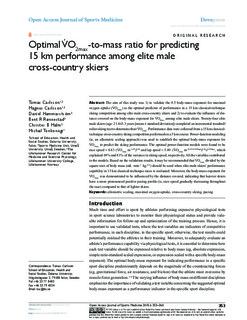| dc.contributor.author | Carlsson, Tomas | |
| dc.contributor.author | Carlsson, Magnus | |
| dc.contributor.author | Hammarström, Daniel | |
| dc.contributor.author | Rønnestad, Bent R. | |
| dc.contributor.author | Malm, Christer B. | |
| dc.contributor.author | Tonkonogi, Michail | |
| dc.date.accessioned | 2016-10-11T07:49:59Z | |
| dc.date.available | 2016-10-11T07:49:59Z | |
| dc.date.issued | 2015 | |
| dc.identifier.uri | http://hdl.handle.net/11250/2414095 | |
| dc.description.abstract | The aim of this study was 1) to validate the 0.5 body-mass exponent for maximal oxygen uptake (V̇O2max) as the optimal predictor of performance in a 15 km classical-technique skiing competition among elite male cross-country skiers and 2) to evaluate the influence of distance covered on the body-mass exponent for V̇O2max among elite male skiers. Twenty-four elite male skiers (age: 21.4±3.3 years [mean ± standard deviation]) completed an incremental treadmill roller-skiing test to determine their V̇O2max. Performance data were collected from a 15 km classical-technique cross-country skiing competition performed on a 5 km course. Power-function modeling (ie, an allometric scaling approach) was used to establish the optimal body-mass exponent for V̇O2max to predict the skiing performance. The optimal power-function models were found to be race speed = 8.83 • (V̇O2max m-0.53)0.66 and lap speed = 5.89 • (V̇O2max m-(0.49+0.018lap))0.43e0.010age, which explained 69% and 81% of the variance in skiing speed, respectively. All the variables contributed to the models. Based on the validation results, it may be recommended that V̇O2max divided by the square root of body mass (mL • min-1 • kg-0.5) should be used when elite male skiers’ performance capability in 15 km classical-technique races is evaluated. Moreover, the body-mass exponent for V̇O2max was demonstrated to be influenced by the distance covered, indicating that heavier skiers have a more pronounced positive pacing profile (ie, race speed gradually decreasing throughout the race) compared to that of lighter skiers. | nb_NO |
| dc.language.iso | eng | nb_NO |
| dc.rights | Navngivelse 3.0 Norge | * |
| dc.rights.uri | http://creativecommons.org/licenses/by/3.0/no/ | * |
| dc.subject | Idrett | nb_NO |
| dc.subject | Langrennski | nb_NO |
| dc.title | Optimal V. O2max-to-mass ratio for predicting 15 km performance among elite male cross-country skiers | nb_NO |
| dc.type | Peer reviewed | nb_NO |
| dc.type | Journal article | |
| dc.subject.nsi | VDP::Medical disciplines: 700::Sports medicine: 850 | nb_NO |
| dc.source.pagenumber | 353–360 | nb_NO |
| dc.source.journal | Open Access Journal of Sports Medicine | nb_NO |
| dc.source.issue | 6 | nb_NO |
| dc.identifier.doi | https://dx.doi.org/10.2147/OAJSM.S93174 | |

